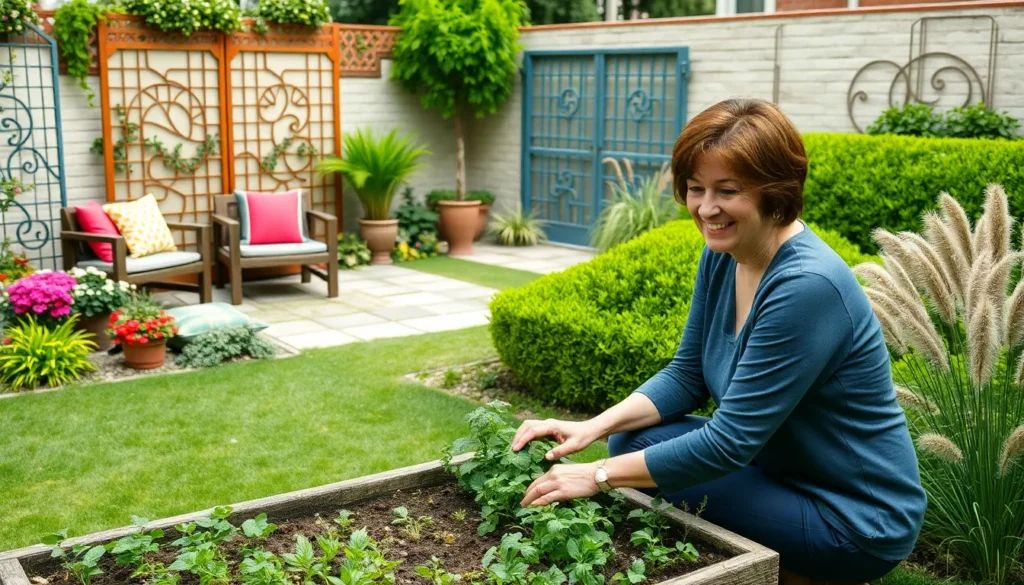Transform Your Garden Into Stunning Separate Spaces
We’ve all stood in our gardens wondering how to create distinct areas without losing that natural flow. Whether you’re dealing with a sprawling backyard or a compact space, dividing your garden strategically can transform it into multiple functional zones that serve different purposes while maintaining visual harmony.
Garden division isn’t just about throwing up a fence and calling it done. We’re talking about creating seamless transitions between your vegetable patch, entertaining area, children’s play space, and quiet reading nook. The right dividers can add height, texture, and structure while providing privacy and defining each area’s unique character.
From living walls of climbing plants to artistic screens and natural stone barriers, we’ll explore creative answers that’ll make your neighbors peek over the fence with envy. These ideas work whether you’re separating a meditation corner from your herb garden or creating a cozy dining area away from the kids’ sandbox.
Create Natural Barriers With Hedges And Shrubs
Living boundaries offer one of the most elegant answers for garden division. We’ll explore how strategic plant placement creates functional zones while adding natural beauty to your outdoor space.
Choose Evergreen Options For Year-Round Privacy
Evergreen hedges provide consistent screening regardless of the season. Boxwood remains our top choice for formal gardens, growing 3-6 inches annually and reaching heights between 4-6 feet when maintained properly. We recommend planting specimens 18-24 inches apart for optimal coverage.
Privet hedges deliver faster results, growing up to 2 feet per year and tolerating various soil conditions. These hardy shrubs create dense barriers within 2-3 years when planted correctly. Yew varieties offer exceptional longevity, with some specimens living over 100 years while maintaining their structural integrity.
Arborvitae creates tall privacy screens, reaching heights of 10-15 feet at maturity. We suggest using these conifers for larger garden divisions where substantial screening is necessary. Leyland cypress grows even faster, achieving 3-4 feet of growth annually for homeowners seeking quick results.
Select Flowering Shrubs For Seasonal Color
Flowering hedge options transform garden boundaries into stunning displays throughout growing seasons. Forsythia bursts with bright yellow blooms in early spring, creating cheerful divisions between garden areas. We plant these shrubs 4-5 feet apart to allow for their naturally arching growth pattern.
Weigela produces tubular flowers in pink, red, or white from late spring through summer. These deciduous shrubs reach 6-10 feet tall and provide excellent seasonal interest while maintaining their dividing function. Spirea varieties offer delicate white or pink flower clusters, with compact cultivars perfect for smaller garden sections.
Hydrangeas create spectacular summer barriers with their large flower heads measuring 6-12 inches across. We recommend panicle hydrangeas for their sturdy stems and reliable blooming, while mophead varieties work well in partially shaded locations. Rose hedges combine fragrance with visual appeal, though they require more maintenance than other flowering options.
Consider Growth Rate And Maintenance Requirements
Fast growing options provide quicker garden division but often demand more frequent pruning. Bamboo varieties can grow 2-4 feet annually, creating instant privacy screens in just one growing season. We caution that running bamboo types require root barriers to prevent unwanted spreading into neighboring garden areas.
Moderate growth hedges balance establishment time with long term manageability. Holly shrubs grow 6-12 inches yearly, developing into dense barriers over 3-4 years with minimal pruning needs. Viburnum species offer similar growth rates while producing fragrant flowers and colorful berries for added garden interest.
Slow growing varieties require patience but deliver superior longevity with reduced maintenance. Japanese yew grows only 4-6 inches annually but maintains perfect form for decades with light annual trimming. We calculate that homeowners save approximately 60% on long term maintenance costs by choosing slower growing hedge materials that retain their shape naturally.
Install Decorative Fencing Solutions
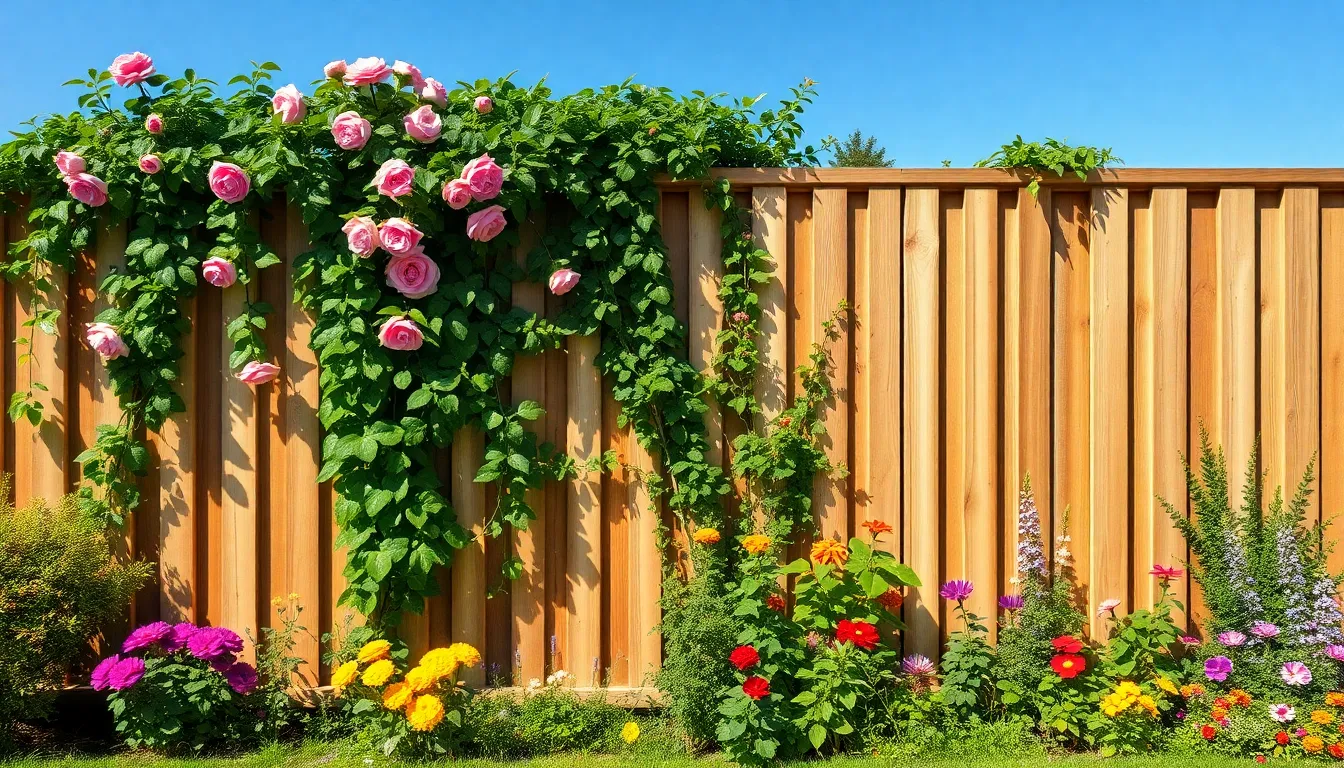
Decorative fencing provides both functional boundaries and aesthetic appeal to your garden division strategy. These structured elements complement natural barriers while offering immediate privacy and visual definition.
Explore Wooden Fence Designs And Styles
Wooden fences offer a classic look that adapts to various garden themes and architectural styles. We recommend horizontal designs for contemporary spaces, as they create clean lines that emphasize width and make smaller gardens appear larger. Vertical picket styles work beautifully in traditional cottage gardens, providing a charming backdrop for flowering plants and vegetable beds.
Lattice designs present another versatile option that combines privacy with partial visibility. These decorative patterns allow air circulation while supporting climbing plants effectively. Cedar and redwood naturally resist weathering and insects, making them excellent long-term investments for garden boundaries.
Board-on-board construction delivers maximum privacy while maintaining visual interest through alternating panel placement. This style prevents gaps that develop over time as wood naturally expands and contracts with seasonal changes.
Consider Metal Fencing For Modern Appeal
Metal fencing answers provide sleek contemporary aesthetics that complement modern garden designs perfectly. Aluminum options resist rust and require minimal maintenance while offering clean geometric lines that enhance structured garden spaces. Steel fencing delivers superior durability and can support heavier climbing plants without sagging or warping over time.
Wrought iron creates elegant decorative elements with intricate patterns that serve as garden art while dividing spaces. These ornamental designs work particularly well around formal gardens, courtyards, and entertainment areas where visual sophistication matters most.
Powder-coated finishes protect metal surfaces from weather damage while offering color options that coordinate with existing industry elements. Black and dark bronze tones blend seamlessly with natural surroundings, while lighter colors create striking contrasts against green foliage.
Add Climbing Plants To Soften Hard Lines
Climbing plants transform rigid fence structures into living walls that provide natural beauty and enhanced privacy. Ivy creates dense coverage quickly, though it requires regular pruning to prevent overwhelming adjacent plants and structures. Clematis offers spectacular seasonal blooms in purple, pink, white, and yellow varieties that attract beneficial pollinators to your garden.
Roses climb naturally along fence supports, producing fragrant flowers throughout growing seasons while creating romantic garden atmospheres. We suggest selecting disease-resistant varieties that thrive in your exact climate conditions for best results.
Jasmine provides evening fragrance and delicate star-shaped flowers that illuminate fence lines during twilight hours. This vigorous climber establishes quickly and tolerates various soil conditions while requiring minimal care once established.
Virginia creeper delivers brilliant fall color that transforms plain fences into seasonal focal points. This native climber supports local wildlife while providing four-season interest through changing foliage colors and winter stem architecture.
Build Raised Garden Beds As Dividers
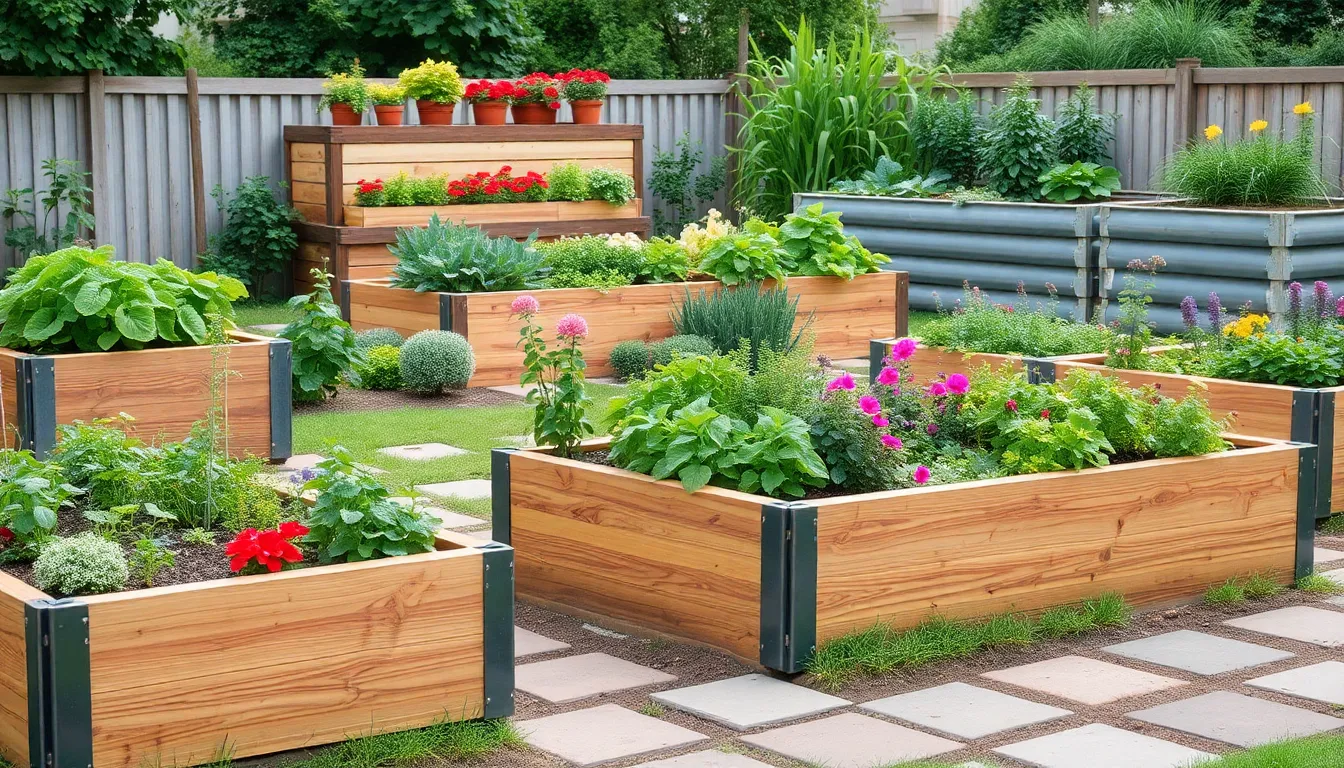
Raised garden beds serve as excellent structural elements that naturally divide garden spaces while providing elevated planting opportunities. These functional dividers create clear boundaries between different garden zones such as vegetable patches, herb gardens, and flower beds.
Design Elevated Planters For Visual Separation
Elevated planters offer strategic height variation that creates visual interest and natural boundaries throughout your garden space. We can position these planters to separate seating areas from active growing zones or establish privacy screens using tall plants like ornamental grasses or shrubs.
These planters work exceptionally well when placed strategically to define distinct functional areas. Wood, metal, and composite materials allow us to customize the style and texture while maintaining the planting functionality we need.
The height advantage of elevated planters makes them perfect for creating layered landscapes. We can use them to establish sight lines that guide visitors through different garden zones while maintaining the open feel of the space.
Choose Materials That Complement Your Industry
Material selection plays a crucial role in creating cohesive garden division that harmonizes with our existing industry design. Natural wood provides a rustic, organic appearance that blends seamlessly with traditional garden settings and complements existing wooden structures.
Stone options offer durability and timeless appeal that works well in both formal and informal garden designs. We can select from fieldstone, limestone, or manufactured stone blocks depending on our budget and aesthetic preferences.
Metal materials like galvanized steel or aluminum provide modern, clean lines that suit contemporary garden designs. These materials offer excellent longevity and can be powder coated for weather protection and color customization.
Terracotta and ceramic materials bring warmth and Mediterranean flair to garden spaces. We should ensure these materials match our climate conditions since they can be susceptible to freeze damage in colder regions.
Create Multi-Level Gardening Opportunities
Multi-level gardening maximizes our available space while creating natural division through varied heights and planting levels. This approach allows us to accommodate different plant requirements within distinct zones of our garden.
Terraced plantings work exceptionally well on sloped terrain where we can build stepped raised beds that follow the natural contours. Each level can serve different purposes, from vegetables at ground level to ornamental plants at higher elevations.
Staggered planter arrangements create depth and visual interest while serving as effective space dividers. We can arrange planters at different heights to create flowing transitions between garden areas without creating hard barriers.
The varied elevation approach makes gardens feel larger and more ever-changing than flat, single-level designs. Different planting levels allow us to create microclimates that support diverse plant species while maintaining clear functional boundaries.
Use Pergolas And Trellises For Vertical Division
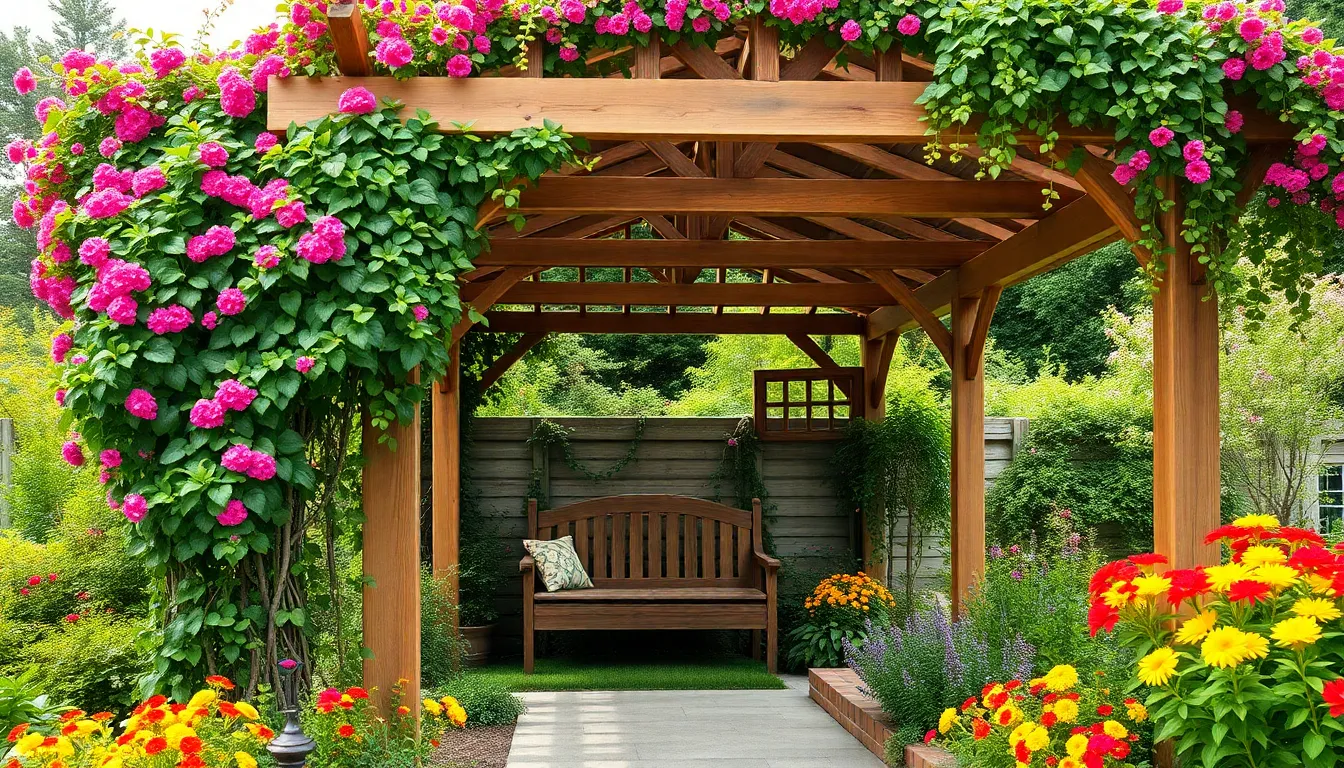
Vertical structures transform flat garden layouts into ever-changing spaces with defined zones and enhanced visual appeal. These architectural elements create natural boundaries without sacrificing the open feel we love in outdoor spaces.
Install Overhead Structures For Climbing Plants
Arbors serve as stunning gateways between different garden sections while supporting vigorous climbing plants like clematis, honeysuckle, and climbing roses. We recommend positioning these structures at transition points where pathways connect various garden zones.
Trellises provide essential frameworks for vertical plant growth and instantly define boundaries between vegetable gardens, flower beds, and seating areas. Metal trellises offer durability for heavy climbers like grape vines, while wooden versions complement cottage garden aesthetics with jasmine and morning glories.
Pergolas create substantial overhead coverage that naturally separates entertaining spaces from quieter garden retreats. We suggest installing these structures over patios, walkways, or dining areas where climbing plants can establish living ceilings that provide seasonal shade and privacy.
Create Shaded Seating Areas Within Garden Zones
Strategic placement of pergolas transforms unused corners into inviting retreat spaces that feel distinctly separate from active garden areas. We position these structures to capture morning sun while providing afternoon shade for comfortable outdoor relaxation.
Gazebos offer complete overhead protection and create intimate seating zones that function as outdoor rooms within larger garden layouts. These structures work particularly well in corner locations where they anchor garden design while providing clear visual separation from surrounding planting areas.
Trellis panels with integrated seating maximize space efficiency by combining functional boundaries with comfortable resting spots. We incorporate built-in benches or attach seating directly to trellis structures, creating cozy nooks that invite contemplation while defining garden zones.
Add Architectural Interest With Custom Designs
Decorative metalwork elevates simple trellises into striking focal points that divide spaces while adding sophisticated visual appeal. We recommend powder-coated steel or aluminum designs that withstand weather exposure while maintaining clean lines and modern aesthetics.
Stone pillar supports create substantial vertical elements that anchor pergola structures and establish permanent garden divisions with timeless appeal. These foundations accommodate various overhead materials from traditional timber beams to contemporary metal frameworks.
Custom screen designs incorporate artistic elements like geometric patterns, laser-cut panels, or woven materials that provide privacy while maintaining airflow between garden sections. We suggest coordinating these decorative elements with existing hardscape materials to create cohesive design themes throughout divided garden spaces.
Incorporate Pathways And Walkways
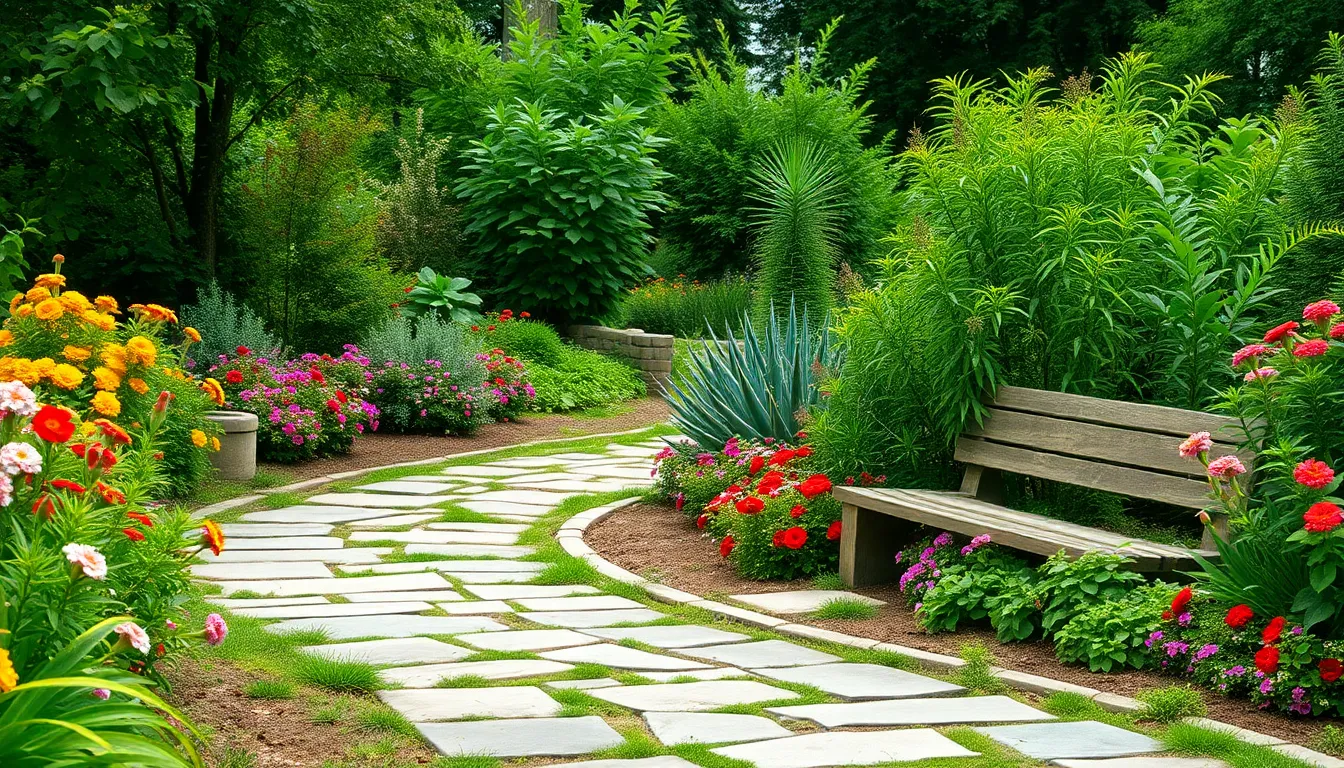
Pathways serve as the backbone of effective garden division, guiding movement while visually separating different zones. We’ll explore how strategic walkway placement creates natural boundaries that enhance both functionality and aesthetic appeal.
Design Stone Or Brick Pathways Between Sections
Stone slabs create timeless elegance that works beautifully in both formal and casual garden settings. We recommend using natural stone for its durability and classic appearance that complements existing industry features. Stepping stones offer a more organic approach, allowing grass or ground cover to grow between each piece for a softer transition.
Brick pathways add traditional charm while providing excellent structure for garden division. Herringbone patterns create visual interest and help define boundaries between vegetable gardens and ornamental spaces. Basket weave layouts work particularly well for connecting entertainment areas to quiet reading nooks, offering a classic design that ages gracefully.
Consider the width of your pathways when planning garden divisions. Main routes benefit from 4-foot widths to accommodate comfortable two-person walking, while secondary paths can be narrower at 2-3 feet for intimate garden exploration.
Create Meandering Routes For Garden Exploration
Curved pathways encourage visitors to discover different garden areas naturally rather than rushing through spaces. We suggest designing gentle S-curves that reveal new views around each bend, creating anticipation and extending the garden experience. Meandering routes work especially well when connecting themed areas like herb gardens to flower borders.
Strategic focal points enhance curved pathway effectiveness for garden division. Place benches at pathway curves to create natural stopping points that define territorial boundaries. Garden statues or decorative planters positioned along meandering routes serve as visual anchors that reinforce section transitions.
Gathering spaces integrated into curved pathways provide natural division points between garden zones. Small clearings with seating arrangements create intimate destinations that separate active areas from contemplative spaces without harsh boundaries.
Use Different Materials To Define Separate Areas
Material transitions provide subtle yet effective garden division without creating visual barriers. Gravel paths work excellently for bordering vegetable patches, offering practical drainage while defining growing areas. Wood chips or mulch pathways complement naturalized garden sections and provide soft walking surfaces for children’s play areas.
Wooden boardwalks excel at defining wetland or water garden boundaries while protecting delicate ecosystems. These elevated walkways create clear separation between bog gardens and traditional planting beds without disrupting natural water flow patterns.
Combining multiple pathway materials creates sophisticated garden division systems. Stone transitions to gravel, then to mulch can guide visitors through formal areas into casual woodland sections. Each material change signals a new garden zone while maintaining continuous flow throughout the industry design.
| Material | Best For | Maintenance Level | Cost Range |
|---|---|---|---|
| Natural Stone | Formal gardens, high-traffic areas | Low | High |
| Brick | Traditional designs, structured layouts | Medium | Medium-High |
| Gravel | Drainage areas, casual paths | Low | Low |
| Wood Mulch | Natural areas, temporary paths | High | Low |
| Wooden Boards | Wet areas, elevated sections | Medium | Medium |
Plant Ornamental Grasses For Soft Boundaries
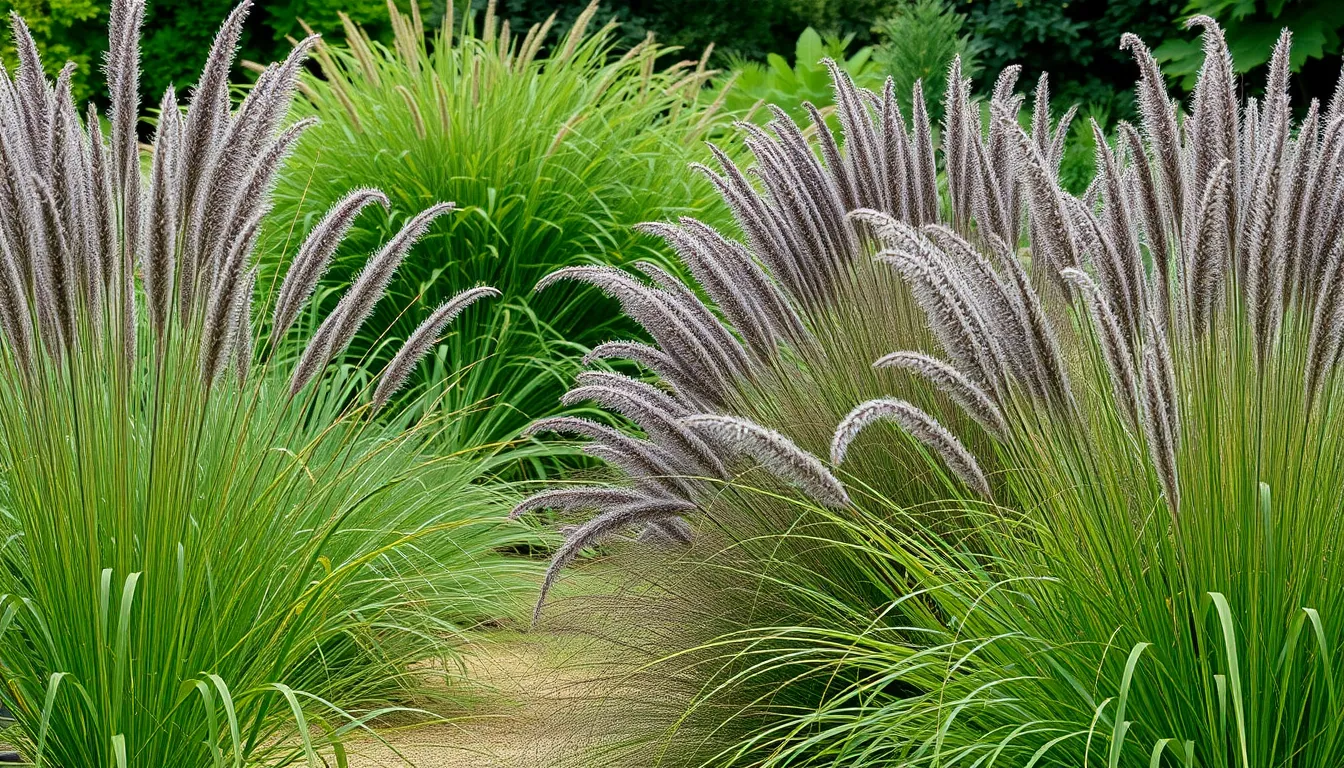
Ornamental grasses offer an elegant solution for creating natural divisions that flow seamlessly with your garden’s overall design. We can achieve beautiful boundaries that add texture and movement without the rigidity of traditional fencing.
Select Tall Varieties For Maximum Impact
Tall ornamental grasses create striking backdrops that naturally separate garden sections. Pampas grass and tall purple moor grass serve as excellent choices for maximum visual impact, reaching impressive heights that define spaces effectively. We recommend positioning these varieties at the back of borders where they’ll create dramatic focal points while dividing different areas.
These towering grasses add vertical interest that draws the eye upward. Their substantial presence creates natural screens that provide privacy without blocking airflow completely. We’ve found that tall varieties work particularly well when separating entertainment areas from quieter garden zones.
Choose Seasonal Grasses For Changing Textures
Seasonal grasses provide ever-changing interest throughout the year with their changing colors and textures. Miscanthus varieties maintain their structural beauty during winter months, offering continued visual appeal when other plants have died back. We can rely on these hardy selections to keep our garden divisions attractive across all seasons.
Winter interest becomes particularly valuable when most garden plants lose their appeal. These grasses retain their form and color during cold months, ensuring our garden boundaries remain defined year round. We appreciate how seasonal varieties create evolving displays that keep our outdoor spaces captivating through changing weather.
Group Different Species For Layered Effects
Grouping different ornamental grass species creates sophisticated layered effects that add depth to garden divisions. Middle layer grasses ranging from 2 to 4 feet tall fill gaps perfectly between taller backdrop varieties and shorter edging plants. We can achieve professional looking borders by combining various heights and textures strategically.
Shorter grass varieties work beautifully as living edgings that define pathways and borders. These compact selections provide gentle transitions between different garden areas while maintaining the natural flow we’re seeking. We find that mixing species with different growth habits creates visual interest that keeps visitors engaged as they move through our outdoor spaces.
Create Water Features As Natural Dividers
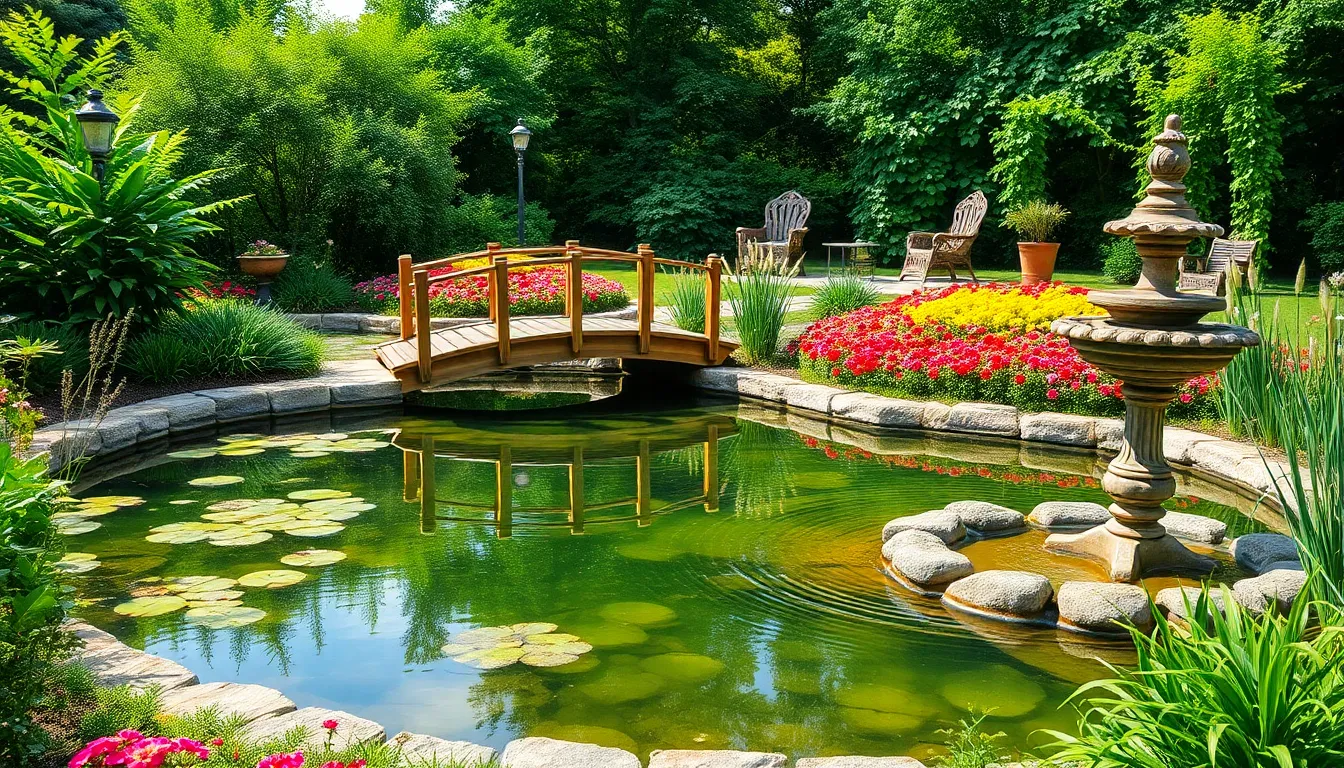
Water features transform ordinary garden boundaries into captivating focal points that naturally separate spaces while adding movement and tranquility. These elements create both visual and auditory barriers that enhance the sensory experience of divided garden areas.
Install Fountains Or Ponds Between Garden Areas
Fountains serve as elegant centerpieces that effectively divide spaces while creating soothing background sounds. We recommend positioning standalone fountains between dining areas and flower beds to establish clear zones without blocking sightlines. Tiered fountains work particularly well for creating multiple levels of visual interest while maintaining the natural flow between garden sections.
Ponds create more substantial divisions that anchor exact garden areas with their reflective surfaces and aquatic plantings. Installing a pond between a vegetable garden and entertainment space provides a serene transition that separates functional zones. We’ve found that kidney shaped ponds integrate more naturally with curved garden designs, while rectangular water features complement formal garden layouts with clean lines and geometric plantings.
Use Streams Or Water Channels As Boundaries
Streams provide ever-changing linear boundaries that guide movement through different garden zones while adding the gentle sound of flowing water. We suggest creating shallow channels that meander between planted areas, allowing visitors to step across easily while maintaining visual separation. These water features work exceptionally well for dividing large lawn areas from flower borders or separating children’s play zones from quiet meditation spaces.
Constructed water channels offer more formal boundary answers that can follow property lines or existing hardscape elements. Installing narrow concrete or stone lined channels creates clean divisions between different garden rooms while supporting aquatic plants along the edges. We recommend incorporating small waterfalls or gentle cascades every 10 to 15 feet to maintain water movement and prevent stagnation.
Add Bridges For Connecting Divided Spaces
Bridges transform water feature boundaries into interactive design elements that invite exploration between garden zones. Simple wooden plank bridges spanning narrow streams create charming focal points while providing practical crossing points. We’ve discovered that arched stone bridges work beautifully over ponds, adding vertical interest and creating perfect photo opportunities within the garden industry.
Decorative stepping stone bridges offer more subtle connections across water features while maintaining the sense of separation between areas. These elements work particularly well for smaller water channels where full bridges might overwhelm the scale. We recommend using materials that complement existing hardscape elements, such as matching stone pavers or timber that coordinates with nearby decking materials.
Design Theme-Based Garden Rooms
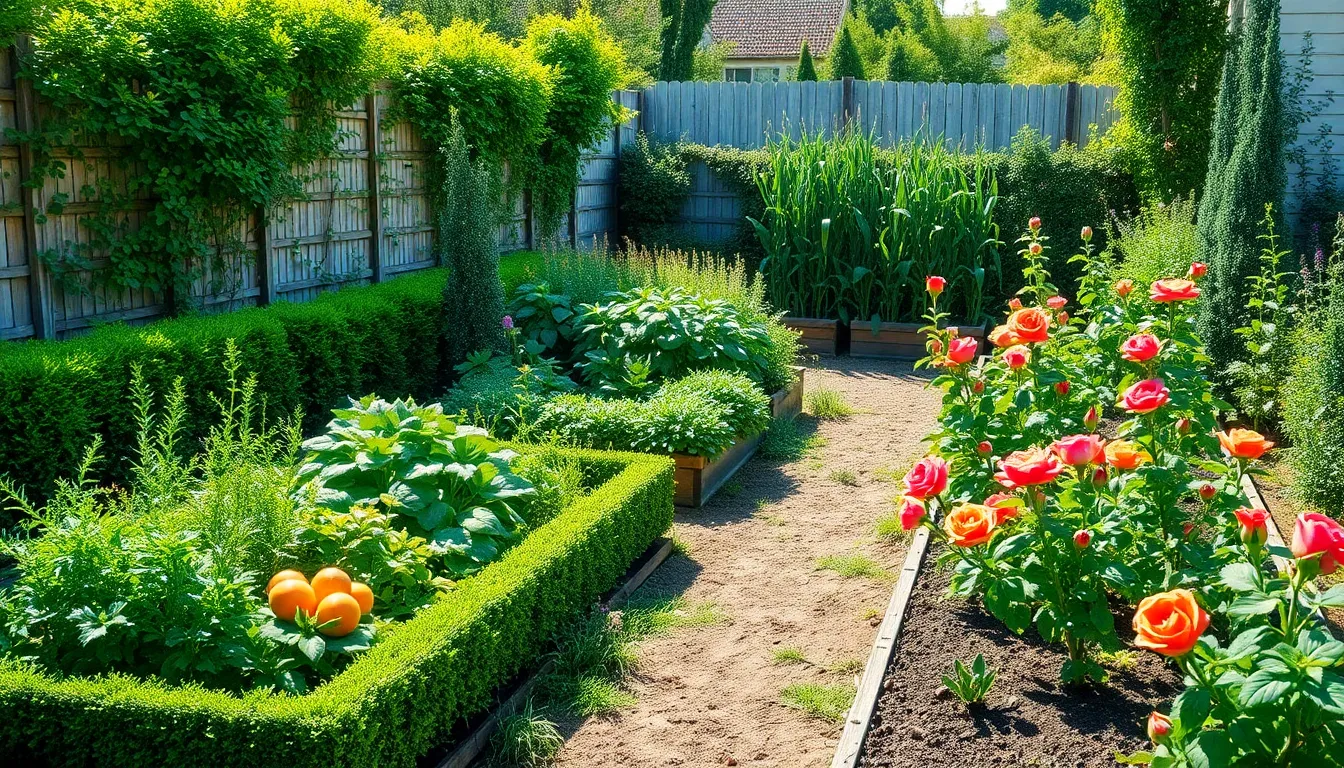
Theme-based garden rooms create distinct zones that serve exact functions while maintaining visual harmony throughout your industry. This approach transforms your outdoor space into a series of interconnected areas, each with its own purpose and character.
Establish Herb Gardens In Dedicated Sections
Herb gardens work best when we establish them in their own dedicated sections, creating aromatic spaces that are both functional and beautiful. Positioning these areas near kitchen windows or outdoor cooking spaces makes harvesting convenient while maintaining the organized flow of your garden design.
Small enclosed gardens using low boxwood hedges or decorative edging define herb spaces without overwhelming the surrounding industry. Raised beds elevate herbs above ground level, creating natural divisions while improving drainage and accessibility for maintenance and harvesting.
Separating culinary herbs like basil, oregano, and thyme from medicinal varieties such as chamomile and lavender helps organize your herb collection based on usage. Mediterranean herbs thrive in sunny, well-drained sections, while moisture-loving herbs like mint perform better in partially shaded areas with consistent watering.
Create Vegetable Plots Separate From Ornamentals
Vegetable plots benefit from separation from ornamental gardens, allowing us to focus on productivity while maintaining aesthetic appeal in decorative areas. This division prevents the utilitarian appearance of vegetable gardens from conflicting with the designed beauty of flower borders and decorative plantings.
Raised beds naturally separate vegetable growing areas from ornamental sections while providing better soil control and easier maintenance access. Garden edging materials like stone, metal, or wood create clear boundaries that guide the eye and define the transition between functional and decorative spaces.
Positioning vegetable plots in sunny locations separate from shade-loving ornamentals ensures each plant type receives optimal growing conditions. Taller vegetables like tomatoes and corn work well as natural screens, creating privacy for seating areas while producing fresh food for your kitchen.
Designate Areas For Exact Plant Collections
Exact plant collections deserve their own designated areas where we can showcase particular species or varieties that share similar growing requirements. Rose gardens create romantic focal points when positioned as standalone sections, surrounded by complementary plantings that won’t compete for attention.
Succulent gardens thrive in well-drained areas separate from water-loving plants, creating interesting textural contrasts through dedicated placement. Labels and exact planters help clearly define these collection areas while providing educational value for visitors exploring your garden.
Seasonal plant collections work effectively when grouped together, allowing us to manage watering, fertilizing, and seasonal care more efficiently. Spring bulb displays, summer perennial borders, and autumn foliage collections each perform better when planted in sections designed for their exact bloom times and maintenance needs.
Conclusion
Creating distinct garden zones doesn’t have to be overwhelming when you have the right approach. We’ve explored many ways to divide your outdoor space while maintaining its natural beauty and functionality.
The key lies in choosing division methods that complement your garden’s existing style and serve your exact needs. Whether you opt for living barriers natural pathways or decorative elements each solution should enhance rather than disrupt your garden’s flow.
Remember that successful garden division is about creating harmony between different areas while giving each zone its own identity. Start with one or two division techniques and gradually build upon them as your garden evolves.
Your divided garden will become a more organized efficient and enjoyable space that serves multiple purposes throughout the seasons.
Frequently Asked Questions
What is garden division and why is it important?
Garden division is the practice of creating distinct functional areas within your garden while maintaining visual harmony. It goes beyond simple fencing to establish seamless transitions between different zones like vegetable patches, entertaining spaces, and quiet nooks. This approach enhances both the structure and usability of your outdoor space.
What are the best natural barriers for dividing a garden?
Hedges and shrubs are excellent natural barriers for garden division. Evergreen options like boxwood, yew, and privet provide year-round privacy and screening. These living walls create elegant boundaries while adding greenery and wildlife habitat to your garden. They’re also more cost-effective than hardscaping solutions.
How can decorative fencing enhance garden division?
Decorative fencing provides both functional boundaries and aesthetic appeal. Wooden and metal fence designs can complement your garden’s style while creating clear zones. Adding climbing plants like clematis or ivy softens hard fence lines and integrates the barrier naturally into your landscape design.
What role do pathways play in garden division?
Pathways serve as the backbone of effective garden division by guiding movement and visually separating different zones. Using materials like stone, gravel, or brick creates natural boundaries between areas while maintaining flow throughout the garden. Well-designed walkways enhance both function and aesthetics.
How do raised garden beds help divide garden spaces?
Raised garden beds act as natural structural dividers while providing elevated planting opportunities. They create clear boundaries between different garden zones without blocking views entirely. These beds are particularly effective for separating vegetable gardens from ornamental areas while adding vertical interest to flat landscapes.
What are theme-based garden rooms?
Theme-based garden rooms are distinct zones within your garden that serve specific functions while maintaining visual harmony. Examples include dedicated herb gardens, rose collections, or succulent displays. Each room focuses on particular plants or activities, creating organized spaces that are both beautiful and functional.
How should I separate vegetable and ornamental gardens?
Separate vegetable plots from ornamental gardens using raised beds, garden edging, or low hedges. This maintains aesthetic appeal while ensuring productive growing conditions. Position vegetable areas in sunny locations with easy access to water, while keeping ornamental displays visible from main viewing areas.
What are the benefits of grouping plants by type or season?
Grouping plants with similar growing requirements creates more efficient garden management. Seasonal collections allow for targeted care and maintenance, while themed plantings like herb gardens or rose beds showcase specific species effectively. This organization improves both plant health and visual impact.

